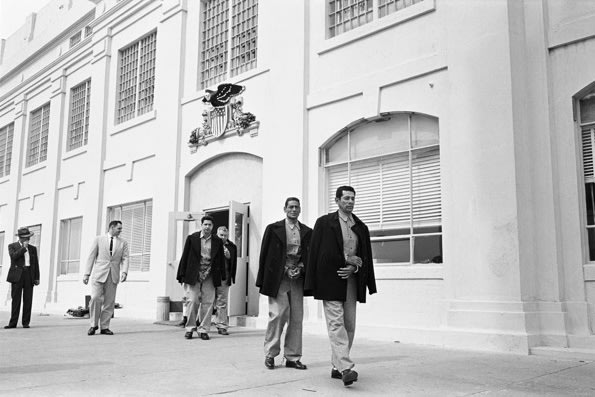When the president of Ohio's state school board posted her opposition to gun control, she used a powerful symbol to make her point: a picture of Adolf Hitler.
When a well-known conservative commentator decried efforts to restrict
guns, he argued that if only Jews in Poland had been better armed, many
more would have survived the Holocaust.
In the months since the Newtown, Conn., school massacre, some gun rights
supporters have repeatedly compared U.S. gun control efforts to Nazi
restrictions on firearms, arguing that limiting weapons ownership could
leave Americans defenseless against homegrown tyrants.
But some experts say that
argument distorts a complex and contrary history. In reality, scholars
say, Hitler loosened the tight gun laws that governed Germany after World War I, even as he barred Jews from owning weapons and moved to confiscate them.
Advocates who cite Hitler in the current U.S. debate overlook that
Jews in 1930s Germany were a very small population, owned few guns
before the Nazis took control, and lived under a dictatorship commanding
overwhelming public support and military might, historians say. While
it doesn't fit neatly into the modern-day gun debate, they say, the
truth is that for all Hitler's unquestionably evil acts, his firearms
laws likely made no difference in Jews' very tenuous odds of survival.
"Objectively, it might have made
things worse" if the Jews who fought the Nazis in the 1943 Warsaw ghetto
uprising in Poland had more and better guns, said historian Steve Paulsson, an expert on the period whose Jewish family survived the city's destruction.
But comparisons between a push by gun control advocates in the U.S.
and Hitler have become so common — in online comments and letters to
newspaper editors, at gun rights protests and in public forums — they're
often asserted as fact, rather than argument.
"Absolute certainties are a rare thing in this life, but one I think
can be collectively agreed upon is the undeniable fact that the
Holocaust would have never taken place had the Jewish citizenry of
Hitler's Germany had the right to bear arms and defended themselves with
those arms," former Major League Baseball pitcher John Rocker wrote in
an online column in January.
After some gun advocates rallied at New York's capitol in February carrying signs depicting Gov. Andrew Cuomo as Hitler, National Rifle Association President David Keene said the analogy was appropriate.
"Folks that are cognizant of the history, not just in Germany
but elsewhere, look back to that history and say we can't let that sort
of thing happen here," Keene, who was the lead speaker at the rally,
told a radio interviewer March 1.
Those comparisons between gun control now and under Hitler joined
numerous other statements, including the one by the Ohio school board
president, Debe Terhar, on her personal Facebook page in January and by
conservative commentator Andrew Napolitano, writing in The Washington
Times.
The comparisons recently prompted the Anti-Defamation League, a
Jewish civil rights group, to call on critics of gun control to keep
Hitler and the Nazis out of the debate.
The rhetoric "is such an absurdity and so offensive and just
undermines any real understanding of what the Holocaust was about," said
Ken Jacobson, the ADL's deputy national director. "If they do believe
it, they're making no serious examination of what the Nazi regime was
about."
But some gun rights advocates firmly disagree.
"People who fail to learn from history are doomed to repeat it," said
Charles Heller, executive director of Jews for the Preservation of
Firearms Ownership, which has long compared U.S. gun control to Nazi
tactics. "I guess if you're pro-Nazi, they are right. But if you're
pro-freedom, we call those people liars."
Comparing gun control activism to Hitler is not new. In a 1994 book,
"Guns, Crime and Freedom," NRA Executive Vice President Wayne LaPierre
wrote that "In Germany, firearm registration helped lead to the
Holocaust."
But the history of civilian gun ownership under the Nazis, scholars say, is far more complicated than the rhetoric indicates.
After World War I, Germany signed a peace treaty requiring
dismantling of much of its army and limiting weapons import and export.
But many of the 1 million soldiers returning home joined armed militias,
including a Nazi Party force that saw Communists as the leading threat.
"Technically, they (the militias)
were illegal and the guns were illegal, but a lot of government
officials didn't care about right-wingers with guns taking on
Communists," said David Redles,
co-author of "Hitler and Nazi Germany: A History," a popular college
text. By 1928, however, officials decided they had to get a handle on
the militias and their weapons and passed a law requiring registration
of all guns, said Redles, who teaches at Cuyahoga Community College in
Cleveland.
Soon after Hitler was named chancellor in 1933, he used the arson of
the Reichstag as an excuse to push through a decree allowing for the
arrest of many Communists and the suspension of civil rights including
protections from search and seizure. But as the Nazis increasingly
targeted Jews and others they considered enemies, they moved in 1938 to
loosen gun statutes for the loyal majority, said Bernard Harcourt, a
University of Chicago professor of law and political science who has
studied gun regulations under Hitler.
The 1938 law is best known for barring Jews from owning weapons,
after which the Nazis confiscated guns from Jewish homes. But Harcourt
points out that Hitler's gun law otherwise completely deregulated
acquisition of rifles, long guns and ammunition. It exempted many groups
from requiring permits. The law lowered the age for legal gun ownership
from 20 to 18. And it extended the validity of gun permits from one
year to three years.
"To suggest that the targeting of Jews in any of the gun regulations
or any of the other regulations is somehow tied to Nazis' view of guns
is entirely misleading," Harcourt said, "because the Nazis believed in a
greater deregulation of firearms. Firearms were viewed, for the good
German, were something to which they had rights."
With the 1938 law, Nazis seized guns from Jewish homes. But few Jews
owned guns and they composed just 2 percent of the population in a
country that strongly backed Hitler. By the time the law passed, Jews
were so marginalized and spread among so many cities, there was no
possibility of them putting up meaningful resistance, even with guns,
said Robert Gellately, a professor of history at Florida State
University and author of "Backing Hitler: Consent and Coercion in Nazi
Germany."
U.S. gun rights
advocates disagree, pointing to the 1943 Warsaw ghetto uprising by
about 700 armed Jews who were able to fend off a much larger force of
German troops for days until retreating to tunnels or fleeing. The Nazis
won out by systematically burning the ghetto to the ground, house by
house.
"Once the Germans began adopting that strategy there really wasn't
very much that people armed with pistols, or even rifles and machine
guns, could do," said Paulsson, the historian and author of "Secret
City: The Hidden Jews of Warsaw."
Paulsson said it is possible that if Polish Jews had limited their
resistance, Nazi troops might not have destroyed the ghetto, allowing
more to survive in hiding or escape. When armed Jews shot at mobs or
troops at other times in 1930s and 1940s Poland, it incited more vicious
counter-attacks, he said.
But to Heller, the gun rights activist, the Warsaw uprising is proof
of power in firearms. Giving Jews more guns might not have averted the
Holocaust, but it would have given them a fighting chance, enough that
perhaps a third of them could have shot their way out of being marched
to the concentration camps, he said.
"Could they have fought back? They did (in Warsaw). You know why they
(the Nazis) destroyed the ghetto? Because they were afraid of getting
shot," he said. "Now, will it get to that in the U.S.? God, I hope not.
Not if (U.S. Attorney General Eric) Holder doesn't start sending people
to kick doors down."
But Paulsson, whose mother was freed from the Auschwitz concentration
camp at the end of the war, dismisses that argument as twisting the
facts.
"Ideologues always try to shoehorn history into their own categories
and read into the past things that serve their own particular purposes,"
he said.





 U.S.News
& World Report gives us a list of the most overpaid jobs -which
aren't necessarily jobs that pay the most. It's a subjective list in
which a person is well-paid for work that's not all that difficult,
involves little stress, and provides little benefit in the end. Even
some of the people in these occupations agree. Here's a sampling:
U.S.News
& World Report gives us a list of the most overpaid jobs -which
aren't necessarily jobs that pay the most. It's a subjective list in
which a person is well-paid for work that's not all that difficult,
involves little stress, and provides little benefit in the end. Even
some of the people in these occupations agree. Here's a sampling:



















 A
woman at an airport in China tried to get through security with a
bottle of a liquid. Officials told her that she'd have to drink it
immediately or throw it away. She drank it, but wouldn't swallow:
A
woman at an airport in China tried to get through security with a
bottle of a liquid. Officials told her that she'd have to drink it
immediately or throw it away. She drank it, but wouldn't swallow: